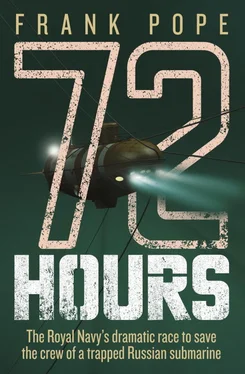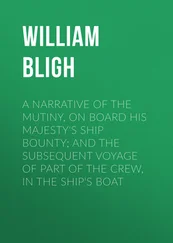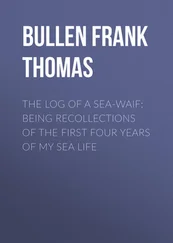The dogs weren’t making anything easier, either. Every time anyone moved about on deck, the huge black Rottweiler half-breed on the bridge deck above would give a blood-curdling series of barks. The German Shepherd guarding the main deck would respond fiercely, while guarding the one patch of deck that the team needed to get to. When not actively defending its territory it was marking it out, relieving itself on Scorpio and the control cab. Trying to shoo it away was treated as an attack. Eventually, it was led away by one of the crew, leaving only a spaniel wandering the aft deck.
By 09.00, all the circuit boards inside both of Scorpio’s pods had been re-seated, connectors had been changed and everything that could be re-secured with duct tape had been. Before re-sealing the pods, Gold took a deep breath and went back to the control cabin to try powering up the vehicle again. If Scorpio didn’t work this time, he didn’t know what he was going to do. He’d tried everything.
He flicked the switch. For a second everything seemed to freeze, and then all four camera screens burst into life with images of rusting deck. Gold’s eyes flicked from gauge to gauge, checking power levels and sensor functions. He turned a dial on the sonar and felt his stomach unclench as its familiar wedge of orange static sprang on to the screen.
He didn’t cheer, not yet. He walked to the container door and looked out at Nuttall, and nodded quietly. Moving back indoors, he flicked through the lights one by one.
‘Front main check good, rear check good,’ came the call. This was more like it. He switched on the hydraulic pump, and moved the joystick forward. He could hear the comforting whirr of the thrusters before Nuttall confirmed it.
‘Dive thruster check good,’ Nuttall shouted. Gold move the stick to the left, then the right. ‘Lateral one check good, two check good,’ he heard.
They were in business. The only thing that seemed strange was that the main front camera was showing a picture in black and white, not colour. He’d never seen that before, but Gold put it down to the low voltage, which was still hovering around the 375-volt mark. He sat down heavily in the pilot’s chair and let the relief flood through him. Nuttall walked in with a lopsided grin. ‘Whisky?’ he said.
‘That’d do the trick, aye,’ said Gold. ‘But not yet.’
Nuttall usually brought some whisky along – his father had shares in the Arran distillery, shares that paid out in different vintages of malt rather than in cheques. But they were a long way from being able to celebrate anything. They still needed to get the casings back on the pods; sealing them up properly was vital. It was all too easy to rush putting things back together, and at the pressures which Scorpio would soon be experiencing, a small mistake would mean a flood of water and a dead vehicle.
First the seats of the O-ring seal were carefully cleaned to make sure they were free of any grit, then the rubber O-rings themselves were inspected and greased with a thin film to help them slide around and seal any minute gaps. With the lid carefully placed, the hex bolts around the casing were screwed in on alternate sides, ensuring an even application of pressure. Although each member of the team had done it hundreds of times before, none of them were any less cautious. Mistakes here were easy and this time they would be expensive, not just in electronics but in terms of human life.
Just as KIL-27 ’s engines began to slow, indicating that they’d reached the site, Scorpio was back together again. At last, holding a steaming cup of coffee, Gold looked across the deck and out over the western Pacific. While the ship’s crews sorted out the unorthodox mooring arrangement, he’d have a little time to gather his thoughts for the next phase of the rescue. Seeing calm sea and its unruffled surface, he could hardly believe their luck. More than anything, good weather could be a lifesaver. It didn’t matter where in the world you were – you could be right off the Scottish coast, surrounded by the best underwater intervention technology available, and if the sea was in a bad mood then there was nothing that could be done until the storm had cleared.
Saturday, 6 August/Sunday, 7 August
SS + 64 h 50 mins
00.20 UK – 03.20 Moscow – 09.20 Kamchatka
Rescue fleet, Berezovya Bay
The time was 09.20, and KIL-27 was wallowing in the limp sea. Tugs were pushing the Alagez , a large submarine salvage and rescue vessel that was acting as the command ship, and the KIL-168 , a Kashtan-class rescue and crane ship, into position with excruciating slowness. Huge black clouds burst from the tugs’ funnels and water churned from their sterns, but progress was slow. Podkapayev’s plan was that together the two big vessels would hold KIL-27 in position, with the Alagez across the bow with three anchors out and KIL-168 tethered astern with a single anchor stretching from her bow. The several large and small tugs would help with the precision control.
A light wind was blowing from the south-west, accompanied by a slight rolling swell, but essentially the weather was perfect. Wires were attached to both KIL-27 ’s bow and stern, and stretched towards the Alagez and the KIL-168 , but manoeuvring was not easy. There were two little tugs bumping and boring into the starboard side, trying to shove the ship laterally into position.
The Submarine Rescue Service’s initial estimate – made just hours after they’d heard of the accident – had been that they’d make contact with the trapped submersible within 36 hours and now, despite the countless delays, they’d at least made it to the accident site in that time. Commander Riches pulled out one of the three laptop-sized satellite phones they’d brought with them and began to set it up on the deck outside the Scorpio control cabin; he wanted to report the good news to the MOD command centre in Northwood. He twisted the antenna towards the equator, then realised there was an enormous iron derrick in his way. Holding the bulky equipment in front of him he shuffled towards the bow, looking for a spot with a clear view of the sky that wasn’t guarded by the dogs. That’s when he spotted one of the American divers, apparently delivering a report to his CO on an Iridium satellite phone no bigger than an early mobile phone. He felt a flash of envy. Then he remembered where he was. If he was feeling resentful at technology five years ahead of his, how must the Russians feel about being surrounded by gear that was 30 years ahead of theirs?
Gold had asked Podkapayev to put their ship in a position where the trapped submersible would be between 150 and 250 metres off their port beam. They needed their ship to be far enough away to be clear of the Russian submersible if they managed to free it and it came shooting to the surface, but not so far that Scorpio became uncontrollable. The umbilical cable that joined Scorpio to the ship was slightly heavier than water, and if there was too much off the reel it would start to drag the vehicle backwards.
On a vessel with Dynamic Positioning, getting themselves in the right spot, and facing the right direction to deploy Scorpio over the port side, would have been a matter of clicking on the desired spot on a digital map and setting the orientation of the ship. Thrusters would hold the ship on those exact coordinates until they – or the weather – decided it was time to move her off. Dynamic Positioning was like being strapped in one position despite the shifting surface of the sea. Their current, makeshift system of being strung between two ships was more like working from a kite blowing in the wind. If things started to go wrong, they’d go wrong very quickly.
Читать дальше












